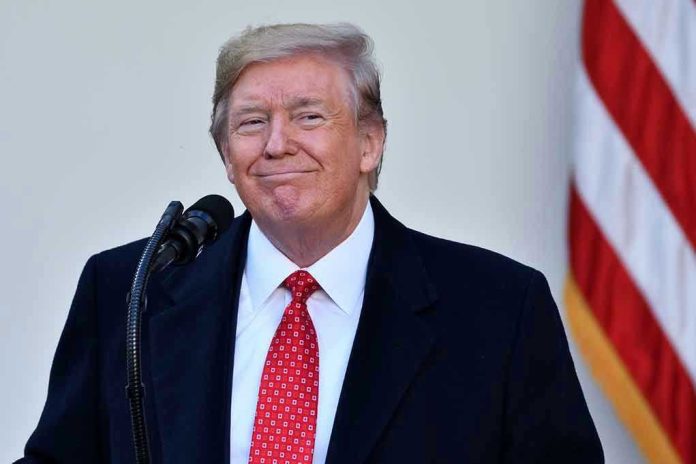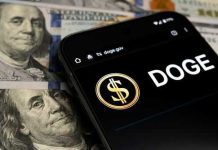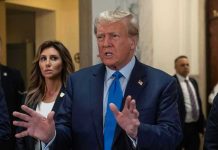
Imagine being promised a $2,000 check by the president—funded not by taxes, but by making foreign companies pay up—and realizing almost no expert thinks you’ll ever see a dime.
Quick Take
- Trump’s $2,000 “tariff dividend” checks hinge on Congress and a legal maze.
- Tariff revenue falls hundreds of billions short of what’s needed for the plan.
- Checks might arrive in mid-2026—if the plan survives legal, fiscal, and political scrutiny.
- Economists warn of inflation, insufficient funds, and mounting national debt.
Trump’s Tariff Dividend: Cash Windfall or Campaign Mirage?
Donald Trump’s latest economic gambit is as audacious as it is simple: direct $2,000 checks to Americans, paid for by tariffs on imports, with the first payments promised by mid-2026.
Announced in November 2025, this “tariff dividend” is pitched as a populist answer to economic anxiety and a rebuke of deficit-funded stimulus.
Trump’s allies are flooding Congress with calls for support, touting the plan as both bold and necessary—yet the path from campaign podium to American mailboxes is tangled in controversy and skepticism.
With inflation stubbornly high and the national debt soaring past $37 trillion, the plan’s timing is no accident. Trump’s team is betting that direct payments—funded by making “China and other countries pay”—will resonate with working Americans weary of economic uncertainty.
But this promise faces a cascade of hurdles, from the Supreme Court’s ongoing review of presidential tariff powers to a Congress deeply divided over fiscal priorities. The very novelty that makes the plan headline-grabbing also makes it a legal and logistical quagmire.
Money Math: The Tariff Revenue Mirage
Trump’s proposal is unique: instead of using deficit spending or raising taxes, he wants to fund checks with revenue collected from tariffs on foreign goods. On paper, it sounds like a win-win—foreign companies pay, Americans benefit. In reality, experts see a chasm between promise and practicality.
John Ricco of the Yale Budget Lab estimates the plan would cost around $600 billion, yet current tariff revenue could cover little more than half that amount, leaving a $300–$400 billion shortfall. Erica York of the Tax Foundation was blunt: “The numbers just don’t check out.”
Previous stimulus checks, such as those sent during the COVID-19 pandemic, were funded by borrowing—adding to the national debt but delivering immediate relief. The “tariff dividend” instead bets on trade policy as a cash cow.
But tariffs are a double-edged sword: while they do generate revenue, they also raise costs for American businesses and consumers, often leading to higher prices on everyday goods.
The net effect, economists warn, could be inflation that eats away much of the proposed benefit—and more.
Legal, Political, and Economic Hurdles: Who Says Yes, Who Says No?
Congress remains the ultimate gatekeeper. While the president can impose tariffs, only Congress controls how that money is spent. As of mid-November 2025, no legislation for the checks has even been introduced, and skepticism among lawmakers—across party lines—is high.
Legal scholars point to the Supreme Court’s review of executive tariff powers, a wildcard that could scuttle the plan before a single check is cut. The White House concedes the details aren’t final and has floated alternatives, including possible tax cuts.
Trump’s congressional allies, eager for a political edge, frame the proposal as a populist masterstroke. Opponents—many with conservative fiscal credentials—warn that using tariffs as a piggy bank is both risky and unproven.
With inflation fears running high, even some traditional stimulus supporters question whether new checks would simply fuel higher prices. Meanwhile, key budget committees and economic think tanks are dissecting the math, searching for a path that balances relief with responsibility.
Checks, Balances, and Unanswered Questions
The impact of the plan, if it ever materializes, would ripple far beyond the recipients. American importers and retailers could face higher costs, passing them on to consumers.
Financial markets may grow jittery amid policy uncertainty and mounting debt. For families counting on the checks, the timeline is as uncertain as the funding—mid-2026 is the earliest possible date, and only if Congress, the courts, and fiscal realities align.
Public opinion is split. Some see the promise of $2,000 as a lifeline, others as a mirage. The proposal has already sharpened the national debate about the proper role of government, executive power, and the wisdom of direct payments versus long-term economic reforms.
As the story unfolds, one fact stands out: no credible source claims the checks are guaranteed. Every expert highlights the legal, fiscal, and political minefields ahead. The most certain thing about Trump’s $2,000 tariff check plan is that nothing—yet—is certain at all.
Sources:
What to know about Trump’s plan to give Americans a $2,000 tariff dividend







